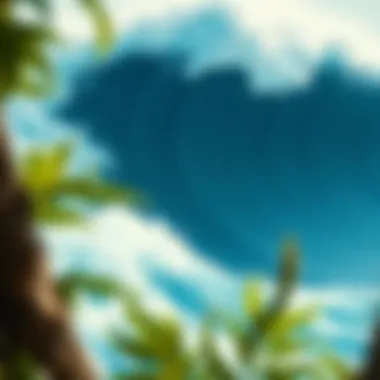The Great Wave: Japanese Art Meets Surf Culture


Intro
Katsushika Hokusai's 'The Great Wave off Kanagawa' is more than just a woodblock print; it's a cultural touchstone that resonates deeply within the realm of Japanese art and surf culture. This iconic piece captures the mighty force of nature and has inspired countless generations, transcending its time for relevance in today’s world.
At first glance, the artwork presents a majestic wave, towering over boats filled with fishermen, as if reminding humanity of its fragility against the power of the ocean. This image has come to symbolize not only the beauty of nature but also the spirit of surfing—an activity born from humanity’s age-old relationship with the sea. As we explore the artistic techniques and cultural significance of the piece, we uncover layers of meaning that speak to both art enthusiasts and those who embrace surf culture.
The intersection of Hokusai's work with the lifestyle and practices of modern surfers reveals a fascinating dialogue. From the materials they use to the techniques they employ, the evolution of surf culture parallels the enduring legacy of 'The Great Wave.' Let's dive deeper into the various facets of the artwork and its unexpected influence on surfing, giving readers a comprehensive understanding of both realms.
Historical Context of The Great Wave
Understanding the historical context of The Great Wave off Kanagawa provides a foundational backdrop for appreciating Hokusai's work and its broader significance in both art and surf culture. This iconic print does not exist in a vacuum; it's a product of its time and place, interwoven with the rich tapestry of Edo period society, nature, and artistic evolution. Delving into this context illuminates the motivations behind Hokusai's choice of subject matter and the techniques he employed.
Hokusai and the Edo Period
Katsushika Hokusai, born in 1760, found himself amidst a cultural renaissance in Japan known as the Edo Period (1603-1868). This era marked a transition from feudalism to a more centralized state, fostering a unique sense of identity and commercial success. Art flourished with the proliferation of woodblock printing, allowing artists like Hokusai to reach wider audiences than ever before. His works were infused with a blend of influences, from traditional Japanese aesthetics to the burgeoning exposure to Western concepts and technologies.
During this time, Hokusai was not merely a painter; he was a relentless innovator who constantly sought to refine his skills. He produced thousands of works including landscapes, portraits, and nature scenes that highlighted the world around him. Yet, it was The Great Wave off Kanagawa, created around 1831, that catapulted his fame into the stratosphere. In this print, the formidable wave dominates the foreground, looming over tiny boats with calm Mount Fuji resting in the background. As if starkly contrasting the power of nature with the insignificance of human efforts against it, Hokusai was able to convey both awe and respect for nature.
A significant factor in this print's creation was the rise of the merchant class who cultivated a taste for art that depicted nature's beauty and the ephemeral quality of life. This connection between nature and human experience was not merely aesthetic; it spoke to a profound relationship that had long been a centerpiece of Japanese culture.
Influences from Nature
Nature was a wellspring of inspiration for Hokusai, as it was for many artists of his time. The Edo period itself was defined by a deep appreciation for the environment. People often looked to the natural world for beauty, lessons, and even solace. Hokusai's landscapes often conveyed deep sentiments about human existence, evoking emotions tied to the cycles and unpredictability of nature.
The wave in The Great Wave off Kanagawa is not just a representation of a common sight; it symbolizes the powerful forces of nature that can inspire both fear and admiration. Hokusai managed to capture the moment of impending chaos - the tumult of the ocean juxtaposed against the stillness of Mount Fuji provides a thoughtful commentary on life's transience.
In addition, this emphasis on nature's beauty and terror can be seen in various Japanese philosophies and art forms. Such philosophies influenced the cultural landscape, encouraging an appreciation for both the ephemeral and eternal, thus making Hokusai’s work deeply resonant within his contemporary society.
"Art is a reflection of our deepest relationship with nature, and Hokusai was a master at capturing that truth in his works."
Through this lens, the historical context of The Great Wave extends beyond just its period of creation, inviting viewers to connect with not only Hokusai's immediate world but also the enduring importance of nature in the human experience. This connection serves as a bridge between traditional Japanese art and modern surf culture, wherein nature remains a central theme, reverberating through the ages.
Artistic Techniques in The Great Wave
The exploration of the artistic techniques utilized in Hokusai's magnificent woodblock print, "The Great Wave off Kanagawa," serves as a gateway into understanding not only the artwork's visual impact but also its enduring cultural significance. These techniques make it a quintessential representation of Japanese art, highlighting the meticulous craftsmanship and artistic philosophy that flourished during the Edo period. By examining both the woodblock printing process and the striking use of color and composition, one can appreciate the level of skill and creativity that went into creating this iconic piece.
Woodblock Printing Process
The woodblock printing process is at the heart of Hokusai's work. This traditional technique, notably used in ukiyo-e, involves multiple stages that require precision and collaboration. Hokusai began by drawing the image onto a paper which was then transferred onto a cherry wood block. Each color in the print requires a separate block, each carefully carved to bring different sections of the artwork to life. This meticulous carving is a true testament to the artists' dedication and patience.
One crucial aspect of this process is the use of removable hand-press methods. The artist would lay down the first block, apply ink, and then use a baren, a hand-held tool, to press the paper onto the block. The successive colors were added in a similar fashion, ensuring that each layer blended harmoniously without drowning out the previous ones. Unique textures and gradients are achieved through various techniques such as bokashi, a method of blending colors that provides depth and vibrancy to the waves, thus bringing movement to what would otherwise be a flat surface.
This painstaking effort distinguishes Hokusai’s print from others—it's a collaborative dance between artist and craftsman, each skilled in their trade, revealing a communal aspect of art that resonates with many in contemporary culture.
Use of Color and Composition
Hokusai's genius also lies in his innovative use of color and composition. The bold blues that dominate "The Great Wave" are not just striking; they tell a story. Derived from a specific pigment known as Prussian blue, it had only recently been introduced to Japan, showcasing Hokusai's willingness to adopt and integrate new ideas. The waves, painted in dramatic blue tones, almost leap off the paper, inviting the viewer into a dynamic dialogue with nature. This fierce and fierce look at the natural world highlights the sometimes precarious relationship between humanity and the ocean, reflecting both beauty and turmoil.
In terms of composition, Hokusai employs a triangular arrangement that draws the viewer's eye upward from the turbulent waves to the distant Mount Fuji in the background. This balancing act—a serene mountain against chaotic waves—is not merely aesthetic but laden with symbolism. Mount Fuji stands as a representation of stability and endurance, juxtaposed with the wave’s violent cresting, serving as a metaphor for life's transience.
The thoughtful layering of elements creates a sense of depth, where backgrounds recede and the foreground pops. Additionally, the interspersed use of negative space provides breathing room around the action, creating tension and harmony. Hokusai's choices are deliberate; they evoke feelings of awe, respect, and even fear towards the power of nature.


The combination of his innovative techniques and profound thematic explorations invites viewers to reflect on their interaction with the world around them.
In summary, Hokusai’s masterful understanding of woodblock printing, color dynamics, and composition not only rendered "The Great Wave" a visual feast but also elevated it to a cultural icon. Exploring these artistic techniques illuminates the pathways through which art interacts with cultural narratives, significantly impacting how we view the combination of art and surfing today.
Cultural Significance of The Great Wave
The legacy of Hokusai's The Great Wave off Kanagawa transcends mere artistic merit; it embodies cultural values and deep-rooted traditions of Japan. The impact this iconic woodblock print has on Japanese culture is profound, echoing the delicate balance between man and nature. In a world often characterized by chaos, this artwork subtly reminds us of humility, respect for the ocean, and the strength of natural forces.
The Symbolism of Waves in Japanese Culture
Waves hold a pivotal role in Japanese culture, often symbolizing the passage of time and life's cyclical nature. Traditionally, waves represent not just the physical embodiment of water but also the emotional turbulence that life brings. In Shinto beliefs, water embodies purification and rebirth. This interplay between the elemental forces can be traced back through Japanese art and poetry, where waves frequently emerge as metaphors for resilience and beauty amidst adversity.
In many respects, Hokusai's waves are alive, painted with a ferocity that speaks of danger yet beckons admiration. The towering, frothy crests in The Great Wave are both intimidating and breathtaking. They capture a duality that reflects the relationship Japanese people maintain with the ocean—an unyielding force filled with both danger and sustenance. Surf culture bears a similar relationship with the waves, where the thrill of riding the surf parallels the cultural acknowledgment of the sea's power.
Interpretations Over Time
Over the centuries, The Great Wave has invited a multitude of interpretations. Originally, during the Edo period, it was perceived as a breathtaking representation of nature's power, a visual sermon that spoke to the Japanese attitude toward the sea. Yet, as Western artists and thinkers encountered this piece, they often appropriated its imagery, imbuing it with their own contemporary meanings. For example, in the late 19th century, artists like Vincent van Gogh admired its intricate detail and bold use of color, leading to a fascination with the aesthetics of Japanese prints among Western circles.
Today, The Great Wave occupies a unique position; it is an emblematic representation of Japanese culture in global art. It is often used in various modern contexts from fashion to advertising as a symbol of inspiration and artistic brilliance. The wave's depiction goes beyond art into discussions about environmentalism, climate change, and humanity's precarious relationship with nature.
"As tides rise, so too does the reflection on our responsibility to the planet, galvanized by the emboldened waves painted centuries ago."
In summary, the cultural significance of The Great Wave remains a dynamic and layered discussion, reflecting not just its artistic prowess but a broader understanding of its role within the intricate web of Japanese culture and beyond.
The Great Wave's Impact on Surf Culture
Hokusai's The Great Wave off Kanagawa holds a unique place in the fabric of surfing culture. The striking image of the towering wave has become more than just an art piece; it has transcended cultural boundaries to symbolize the thrill, power, and unpredictability of the ocean. This influence can be traced through its integration in surf iconography and its pervasive presence in marketing and merchandise related to surf culture.
Integration in Surf Iconography
The symbolism of waves is deep-rooted in surfing, but the Great Wave has taken it to another level. Surfers embrace the image as a representation of their love for the ocean—its beauty, ferocity, and the sheer adrenaline it induces. This iconic artwork pops up everywhere, from surfboards to tattoos, encapsulating the essence of wave riding.
- The Great Wave is often featured prominently on surfboards, serving not just as decoration but a badge of identity. Surfers feel a connection enhancing their experience with the sport and emphasizing a sort of cultural reverence.
- Additionally, numerous surf shops and brands integrate this piece into their logos, tapping into the legend of Hokusai to attract enthusiasts seeking authenticity.
- Social media platforms, like Instagram and Facebook, have become channels for surfers to showcase their boards adorned with this masterpiece, creating a visual dialogue around the sport that ties back to its artful roots.
Ultimately, the wave itself is more than just a thrilling ride; it is a continuous narrative linking surfers globally under the shadow of Hokusai's craftsmanship.
Marketing and Merchandise
The influence of The Great Wave extends into commercial realms, where surfing brands use it to market products that appeal directly to the culture of surf enthusiasts. The artwork's visual power serves as a potent advertisement, inviting surf lovers to invest in products that resonate with their passion for the ocean.
- Apparel brands frequently feature the Great Wave on t-shirts, hats, and swimwear. These items not only promote the artist's work but also align with a lifestyle that champions the surf culture.
- Merchandise ranging from art prints to home decor capitalizes on the cultural significance of Hokusai's work. This creates a sense of ownership for surfers and art lovers alike, who can incorporate elements of the ocean into their daily lives.
- Furthermore, limited edition goods featuring the Great Wave often fetch high prices at auctions, prompting fans to seek collectibles that connect them to both art and their lifestyle.
These marketing strategies not only highlight the integration of art and culture but also feed a flourishing economy built around the passion for surfing.
In summary, The Great Wave off Kanagawa stands as an everlasting emblem of surf culture, embodying the thrill of oceanic adventure while bridging the worlds of fine art and outdoor sport. Its imagery continues to inspire, unite, and create a vibrant economy that celebrates both heritage and modernity.
Comparative Analysis with Other Art Forms
The interplay between various artistic expressions has long influenced creators and spectators alike, and when we look at The Great Wave off Kanagawa, its significance goes beyond its own ink and paper boundaries. This image stands as not just an iconic piece of Japanese woodblock art but also a catalyst that has inspired countless different art forms across the globe. Examining this crossover illuminates how diverse artistic traditions can reflect, reinterpret, and recontextualize one another.
Modern Street Art Inspirations


Street art thrives on the boldness of imagery and socio-political messages. Artists like Shepard Fairey, known for his famous "Hope" poster of Barack Obama, draw from historical contexts like Hokusai’s work to create pieces that resonate with contemporary themes. For instance, Fairey once infused elements reminiscent of The Great Wave in his works, merging the past with the urgent voices of today.
Take a look at these brushes with traditional art:
- Dynamic Compositions: Striking waves and motion depicted in street murals often mimic the energy captured in Hokusai's work.
- Cultural Symbolism: Artists reinterpret waves to address struggles in their communities, akin to how Hokusai portrayed nature's beauty as intertwined with humanity's vulnerability.
These adaptations signify not just artistic homage but a dialog across eras; they elevate The Great Wave to a status where it transcends time and geography. This connection showcases how a work born from Japan's Edo period can find relevance in the gritty alleys of modern cities across the world.
Film and Literature References
Moving into the realm of film and literature, The Great Wave has found its way into narratives, serving as a profound metaphor for conflict and resilience. Films, animated shorts, and even documentaries have explored not only the imagery but the thematic undercurrents of Hokusai's work. For instance, in movies that highlight aquatic adventures, such as Finding Nemo, visual references to giant waves evoke both beauty and peril akin to Hokusai’s original intentions.
Literature, too, weaves in references to Hokusai's wave, often symbolizing emotional upheaval or the tumultuous nature of life's journeys. Multiple poetry anthologies draw comparisons between the relentless force of waves and the struggles of human existence.
Some examples include:
- Short Stories: Authors illustrate characters overcoming obstacles akin to paddling through stormy seas—directly echoing the power illustrated in Hokusai's canvas.
- Poetry: Verses that reflect on waves often bring in Hokusai’s imagery to deepen the emotional resonance, bringing layers of meaning that dance between calm and chaos.
"Art speaks where words are unable to explain." This quote resonates here, as Hokusai’s The Great Wave continues to inspire creators, shaping narratives across multiple artistic realms.
In summary, the comparative analysis reveals that The Great Wave off Kanagawa is not just a standalone masterpiece; it’s a narrative that interlaces with street art’s bold expressions and the layered storytelling of films and literature. Its significance in these various forms demonstrates the enduring beauty and power of artistic influence.
The Great Wave in Contemporary Art
Hokusai's The Great Wave off Kanagawa doesn’t just remain stuck in the past; it continues to be a beacon of inspiration for myriad artists in today’s landscape. The print, with its powerful depiction of nature's fury and man's delicate balance with it, offers a fertile ground for reinterpretation and innovation. Artists around the globe draw from its iconic imagery to express contemporary themes, be it environmental concerns or the quest for identity in a rapidly changing world. By doing so, they don't just pay homage; they elevate Hokusai’s vision to a dialogue that resonates with modern sensibilities.
Reinterpretations by Modern Artists
Modern artists have taken Hokusai's waves and twisted them into forms that reflect current issues. For instance, consider the artist Takashi Murakami. He incorporates Hokusai's wave into his bright, pop-art style, merging traditional Japanese aesthetics with the vibrancy of contemporary culture. This blend isn’t merely aesthetic; it also critiques consumerism. His works ask viewers to reflect on the underlying chaos of modern life through the lens of that famous wave.
Another notable reinterpretation can be found in the environmental art movements. Artists like Olafur Eliasson utilize the imagery of The Great Wave to comment on climate change and rising sea levels. Through installations that mimic the wave, they prompt an urgent conversation about our relationship with nature—a nod to Hokusai, who himself was motivated by the natural world.
Further, the digital art space has seen the wave reimagined in animated formats. These pieces often juxtapose the raw power of the wave with themes of tranquility or vulnerability, showcasing how this singular artwork continues to forge connections to personal and collective narratives.
Role in Art Exhibitions
Art exhibitions have embraced The Great Wave as a centerpiece, often assembling it with other works that explore nature, technology, and identity. Exhibitions like "Hokusai: Beyond the Great Wave" at the British Museum recontextualize the artwork within discussions of influence and innovation. Here, curators showcase not just the print itself but also the myriad ways it has shaped other artistic expressions.
In these settings, The Great Wave becomes a cultural artifact that transcends geography and era. Visitors are invited not just to admire but to engage with the layers of meaning. The dialogue generated by placing Hokusai in conversation with modern installations encourages a blending of ideas across epochs. It’s fascinating to watch audiences connect centuries-old art to modern issues, illuminating a shared human experience.
Additionally, the wave has found a place in mixed media, where it is combined with photography, sculpture, and even technology-driven installations, pushing boundaries and testing the viewer's perception of art itself. This evolution speaks to the timelessness of Hokusai's work, ever relevant and dynamically reinterpreted.
As contemporary artists continue to explore the relationship between man and nature through the lens of The Great Wave, one thing becomes clear: Hokusai's legacy is alive and well, continually surfacing in new and unexpected ways that challenge and excite the art world and beyond.
The Global Influence of The Great Wave
The Great Wave off Kanagawa, one of the most remarkable pieces of art to come out of Japan, has transcended boundaries in its reach and impact. Its influence extends far beyond the shores of Japan, touching various cultures and artistic movements around the globe. This section delves into how this iconic woodblock print has influenced art, design, and even surf culture internationally.
Cross-Cultural Influences
Hokusai’s masterwork stands as a testament to the shared human experience with nature. Across continents and cultures, this wave has inspired countless artists and creators to interpret its form and feeling in unique ways.


- In Europe during the 19th century, artists like Vincent van Gogh drew inspiration from Hokusai's work, integrating its aesthetic into their own lives. Van Gogh’s admiration for Japanese art is reflected in his series of prints that mimic the bold lines and vibrant colors found in The Great Wave.
- Similarly, the Impressionist movement, while distinct, found a certain camaraderie in Hokusai’s portrayal of dynamic motion and light, often evident in their depictions of water scenes.
- In modern urban art, murals inspired by The Great Wave can be found worldwide, showcasing how street artists reinterpret the universal themes of struggle and triumph within this iconic imagery.
Such cross-cultural mixtures support a narrative of connectivity—illustrating how The Great Wave resonates with diverse audiences, prompting them to reflect on their own relationships with the natural world.
Adoption in Various Nations
The adoption of Hokusai’s Great Wave across various nations highlights not just its artistic value but the cultural dialogues it evokes. In different parts of the world, this powerful image has been embraced, reimagined, and celebrated.
- United States: The surf culture in California, heavily influenced by the visual aesthetic of The Great Wave, often portrays it on surfboards and apparel. This embodies a merging of sport and art that resonates deeply with surfers and outdoor enthusiasts.
- Australia: Australian artists have captured the spirit of wave riding by infusing elements of Hokusai's art into their own beach culture, harnessing its imagery to express their relationship with the ocean.
- Brazil: In Brazil, artists have taken inspiration from the design for countless works, often celebrating local landscapes while nodding towards the Japanese techniques that influenced Hokusai decades ago.
"The Great Wave is not merely an image; it’s a bridge across cultures, showing how one piece of art can speak to many hearts and minds."
Each of these examples shows the versatility and adaptability of The Great Wave in depicting the human experience within various cultural frameworks. As it travels across oceans and lands, its meaning morphs while still retaining a core identity—a celebration of the power of nature and the resilience of the human spirit.
In sum, The Great Wave has carved a niche in global culture, serving as a canvas for various expressions and interpretations, while uniting individuals through shared appreciation of nature's grandeur.
Educational Significance in Art History
The significance of Hokusai's 'The Great Wave off Kanagawa' in art history transcends mere aesthetics, weaving a rich tapestry of cultural, technical, and interpretive insights. This woodblock print does not just hang on museum walls; it serves as a vital pedagogical tool that encapsulates the essence of Japanese art while simultaneously influencing the global art landscape. Understanding its educational value fosters a deeper appreciation for artistic traditions and cultural narratives.
Usage in Academic Curriculum
In the realm of academia, 'The Great Wave' enjoys a prominent spot within art history curricula. It's often selected as a case study in various disciplines, spanning from visual arts to cultural studies. Instructors utilize this piece to convey topics such as:
- Historical context: Students engage with the Edo period's socio-economic landscape, discussing how such conditions influenced Hokusai's work.
- Technical analysis: The woodblock printing technique opens discussions on craftsmanship, materials, and the evolution of artistic methods.
- Cultural exchange: This print presents a springboard for exploring how Japanese art made its way into Western collections, influencing artists like Vincent van Gogh and Claude Monet.
These discussions lead students to make connections between art and broader cultural movements, allowing them to grasp the intricate links between artistic expression, societal change, and global interaction.
"Art history is not just about learning the past; it's about understanding how that past shapes our present."
Influence on Upcoming Artists
The impact of 'The Great Wave' on emerging artists cannot be understated. Many contemporary creators draw inspiration from its dynamic composition and emotive power. Here are a few ways it influences their work:
- Symbolism: New artists often interpret the wave as a metaphor for challenges and triumphs, applying similar motifs in today's context.
- Technique: Many successors experiment with replication of the woodblock printing process, blending traditional methods with modern styles. This creates a dialogue between past and present, ultimately honoring Hokusai while innovating further.
- Environmental themes: The wave's overwhelming presence symbolizes nature's unpredictable essence, leading artists to tackle environmental issues in their work, striving to evoke awareness of the impacts of climate change.
In summary, 'The Great Wave’ serves not simply as a relic of the past, but as a living influence for future generations. It propels discussions in art education, enriches artistic endeavors, and fosters a community of creators who respect their heritage while looking forward. With each wave of new interpretations, the legacy of Hokusai stretches far beyond the seas of time.
Finale: The Enduring Legacy of The Great Wave
No other piece of art evokes such a profound connection between nature and culture as Hokusai's The Great Wave off Kanagawa. Its legacy stretches far beyond its original creation in the Edo period, establishing itself as an emblem of resilience and artistic mastery. The enduring significance of this work lies in how it captures the tempestuous beauty of the ocean and the relentless human spirit amidst nature's grandeur. It speaks volumes about the hopes, fears, and experiences that come with facing overwhelming forces, which resonates deeply even in modern surf culture.
Reflection on Artistic Heritage
Hokusai’s piece is not simply a beautiful woodblock print; it’s a testament to Japan’s artistic heritage and its relationship with the sea. The image of the giant wave looming over the boats isn’t merely a visual thrill; it encapsulates the intricate bond between man and nature and the delicate balance of life. From the perspective of artistic lineage, it has shaped not just Japanese art, but global art movements, influencing countless artists like Vincent van Gogh and Claude Monet. Its presence can be felt in varying art forms, from classic techniques to modern interpretations.
The Great Wave serves as a bridge connecting traditional ukiyo-e techniques with contemporary art essays, fostering dialogue among artists who continuously reinterpret its themes. Today, you will find elements of the wave echoed in street art, tattoo culture, and even digital illustrations, reinforcing its status as a universal symbol.
"In the face of the tumultuous waters, art provides both a refuge and a reminder of our shared human experience."
Future Perspectives
Looking ahead, the potential for The Great Wave in modern contexts seems limitless. As society evolves, so do interpretations of this iconic image. With the rise of environmental consciousness among artists, there’s a burgeoning movement that seeks to use Hokusai’s wave as a symbol in the conversation surrounding climate change and sustainable living. Artists and influencers within the surfing community are re-engaging with the print, encouraging awareness of ocean preservation.
Moreover, as technology transforms the art landscape, the wave could take new shapes through augmented reality, interactive installations, and new media art. This interplay between observing the art and experiences of the ocean creates a dynamic future where The Great Wave transcends its original context, inviting new audiences to connect with its message.
In summary, the enduring legacy of The Great Wave serves as both a reflection of Japan's rich artistic history and a beacon for future explorations into art and culture, ensuring its relevance and resonation for generations yet to come.



